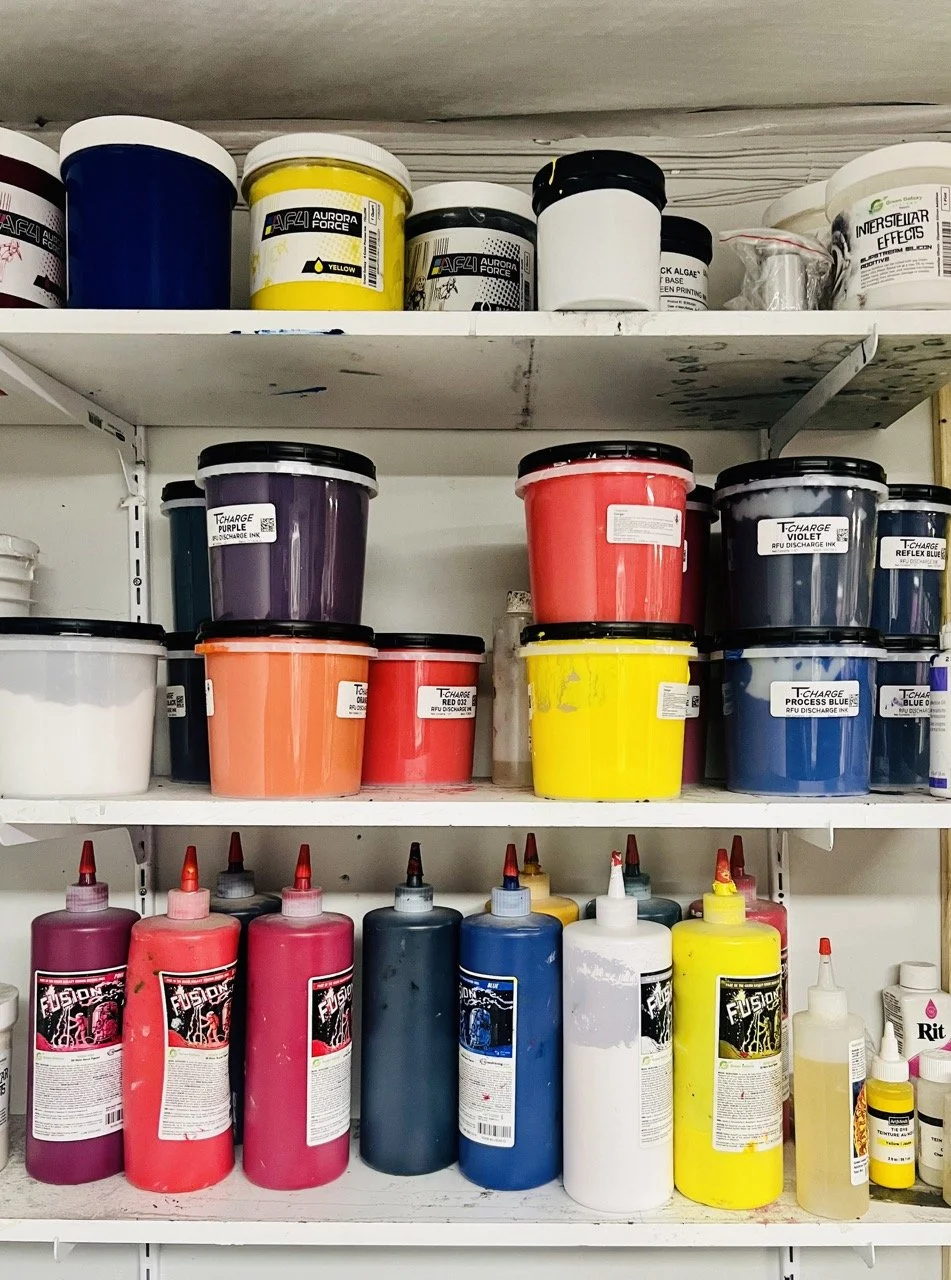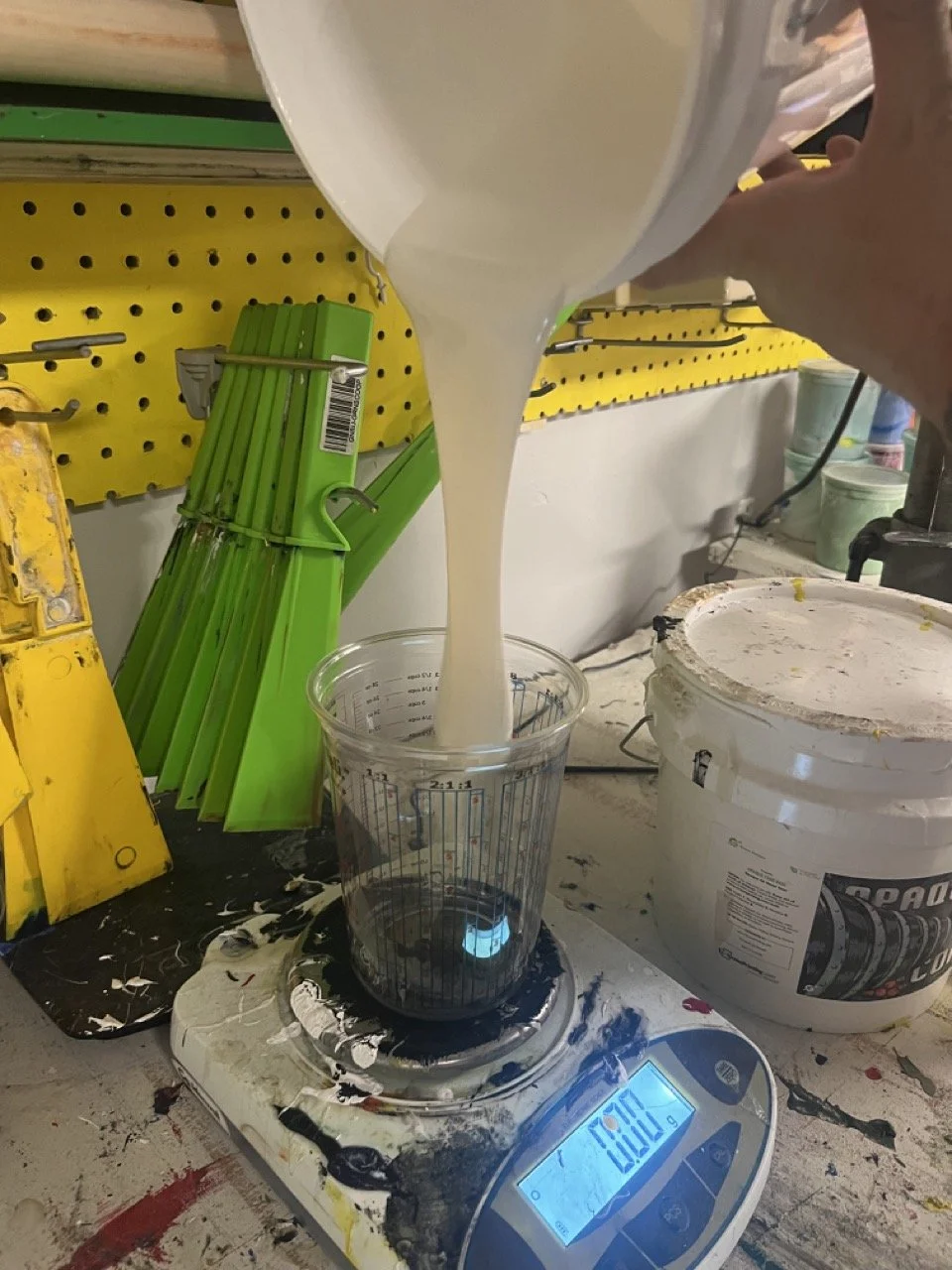Sustainable screen printing materials: A greener approach.
Screen printing is a popular method for creating vibrant designs on various surfaces. However, the traditional materials used in screen printing can have a significant environmental impact. Fortunately, there are now environmentally friendly alternatives available in the market that provide a greener approach to screen printing. In this blog post, we will explore these sustainable options, including water-based and algae-based inks, compare their prices to less environmentally conscious alternatives, and discuss the environmental impact of the screen printing industry.
Our current selection of Water-based inks.
Environmentally Friendly Screen Printing Materials
Water-Based Inks: Unlike traditional plastisol inks, water-based inks are made from natural or synthetic binders mixed with pigments. They do not contain harmful chemicals such as phthalates or PVC, making them a safer and more sustainable choice. Water-based inks are also easier to clean up and produce less waste compared to plastisol inks.
Soy-Based Inks: Another eco-friendly alternative to traditional inks is soy-based ink. These inks are derived from soybean oil, which is a renewable resource. Soy-based inks have lower levels of volatile organic compounds (VOCs), reducing air pollution and minimizing health risks for screen printers.
Algae-Based Inks: A newer and exciting development in the field of sustainable screen printing materials is the use of algae-based inks. Algae is a highly renewable resource that can be sustainably harvested and converted into ink. Algae-based inks offer a viable alternative to traditional inks, as they have lower VOC emissions and require fewer resources to produce. By using algae-based inks, screen printers can further reduce their environmental impact and contribute to a more sustainable printing industry.
Sustainable Clothing Options: When it comes to choosing the base materials for screen printing, there are several sustainable clothing options to consider:
Upcycled Clothing: Upcycling involves transforming old or discarded clothing into new products. By repurposing existing garments, we can reduce the need for new materials and minimize waste. Upcycled clothing not only reduces environmental impact but also adds a unique and creative touch to screen-printed designs. You can find upcycled clothing in thrift stores, online marketplaces, or even create your own by repurposing old garments.
Organic and Recycled Materials: Opting for clothing made from organic or recycled materials is another sustainable choice. Organic fabrics are cultivated without the use of harmful pesticides or synthetic fertilizers, protecting both the environment and the workers involved in the production process. Recycled materials, such as recycled cotton or polyester, help to reduce resource consumption and divert waste from landfills. Many brands now offer clothing made from organic cotton or recycled polyester, ensuring a more sustainable supply chain.
Recycled Polyester: Polyester is a commonly used fabric in the fashion industry, but its production has a significant environmental impact. However, by using recycled polyester, which is made from post-consumer plastic bottles or other recycled sources, we can minimize the reliance on virgin materials and reduce energy consumption. Recycled polyester is becoming more widely available in the market and can be used for screen printing on various clothing items.
Ink Usage and Waste Reduction
Proper management of ink usage and waste is essential in reducing the environmental impact of screen printing. Here are some strategies to consider:
Measure and Mix Carefully: Accurate measurement and mixing of ink quantities can minimize waste. It is crucial to follow manufacturer guidelines and use only the amount needed for each print job.
Screen Reclamation: After printing, screens can be reclaimed to remove excess ink. This process involves using eco-friendly solvents or emulsions to dissolve and clean the screens, allowing for their reuse. By reclaiming screens, we can reduce ink waste and extend the lifespan of printing materials.
Recycling and Proper Disposal: Ink containers, leftover inks, and other printing materials should be disposed of properly. Many ink manufacturers offer recycling programs for empty containers. Unused inks can be donated or shared with other printers to prevent them from going to waste.
Eco-Friendly Cleaning: Cleaning screens and equipment with environmentally friendly solvents or water-based cleaners helps minimize the release of harmful chemicals into the environment. Avoid using harsh chemicals that can contaminate water sources or contribute to air pollution.
Invest in Efficient Equipment: Upgrading to energy-efficient and eco-friendly screen printing equipment can help reduce ink waste and overall environmental impact. Consider equipment that allows for precise control of ink flow and minimizes ink usage.
By implementing these practices, screen printers can significantly reduce ink waste, minimize environmental pollution, and contribute to a more sustainable screen printing industry.
Mixing inks at the shop.
The Environmental Impact of the Screen Printing Industry
The screen printing industry, like any other manufacturing sector, has a significant environmental impact. The use of non-sustainable materials, such as plastisol inks and conventional clothing fabrics, contributes to pollution, waste generation, and resource depletion. Additionally, the improper disposal of screen printing chemicals can harm ecosystems and water sources.
By adopting environmentally friendly screen printing materials, such as water-based, soy-based, and algae-based inks, and utilizing sustainable clothing options, we can minimize these negative effects. Implementing proper waste management practices and embracing eco-conscious practices are crucial steps towards reducing the environmental footprint of the screen printing industry.
In conclusion, sustainable screen printing materials offer a greener approach and help mitigate the environmental impact of this industry. By investing in these alternatives, such as algae-based inks and sustainable clothing options like upcycled, organic, or recycled materials, we can create beautiful prints while preserving our planet for future generations. Let's embrace eco-conscious practices and contribute to a more sustainable and responsible screen printing industry.
Note: At Daze Printing, we speak from a place of knowledge that we have cultivated, but we are always open to feedback and new information on the front of sustainability and the environment. Our goal is to continuously learn and improve our practices for a greener and more sustainable future.
If you are interested in starting the conversation about sustainable screen printing materials or have any questions, feel free to reach out to us. We are here to help and discuss how we can make a positive impact together.


